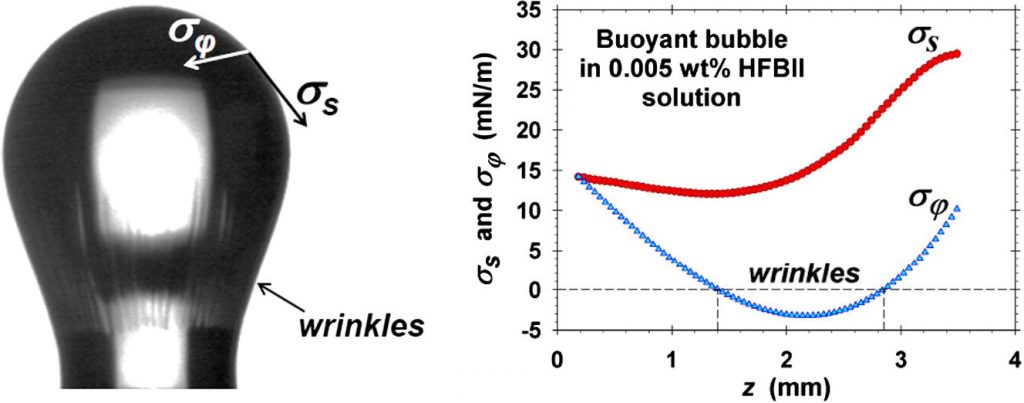
Nikola A. Alexandrov, Chemist
Interests
- Dynamic Interfacial Tension
- Interfacial Rheology
Publications
Most recent publications
Capillary meniscus dynamometry – Method for determining the surface tension of drops and bubbles with isotropic and anisotropic surface stress distributions
The stresses acting in interfacial adsorption layers with surface shear elasticity are, in general, anisotropic and non-uniform. If a pendant drop or buoyant bubble is covered with such elastic layer, the components of surface tension acting along the “meridians” and “parallels”, σs and σϕ, can be different and, then, the conventional drop shape analysis (DSA) is inapplicable. Here, a method for determining σs and σϕ is developed for axisymmetric menisci. This method, called ‘capillary meniscus dynamometry’ (CMD), is based on processing data for the digitized drop/bubble profile and capillary pressure. The principle of the CMD procedure for data processing is essentially different from that of DSA. Applying the tangential and normal surface stress balance equations, σs and σϕ are determined in each interfacial point without using any rheological model. The computational procedure is fast and could be used in real time, during a given process. The method is applied to determine σs and σϕ for bubbles and drops formed on the tip of a capillary immersed in solutions of the protein HFBII hydrophobin. Upon a surface compression, meridional wrinkles appear on the bubble surface below the bubble “equator”, where the azimuthal tension σϕ takes negative values. The CMD method allows one to determine the local tensions acting in anisotropic interfacial layers (films, membranes), like those formed from proteins, polymers, asphaltenes and phospholipids. The CMD is applicable also to fluid interfaces (e.g. surfactant solutions), for which it gives the same surface tension as the conventional methods.

Co-adsorption of the proteins ß-casein and BSA in relation to the stability of thin liquid films and foams
Interfacial layers from the protein HFBII hydrophobin: Dynamic surface tension, dilatational elasticity and relaxation times
The pendant-drop method (with drop-shape analysis) and Langmuir trough are applied to investigate the characteristic relaxation times and elasticity of interfacial layers from the protein HFBII hydrophobin. Such layers undergo a transition from fluid to elastic solid films. The transition is detected as an increase in the error of the fit of the pendant-drop profile by means of the Laplace equation of capillarity. The relaxation of surface tension after interfacial expansion follows an exponential-decay law, which indicates adsorption kinetics under barrier control. The experimental data for the relaxation time suggest that the adsorption rate is determined by the balance of two opposing factors: (i) the barrier to detachment of protein molecules from bulk aggregates and (ii) the attraction of the detached molecules by the adsorption layer due to the hydrophobic surface force. The hydrophobic attraction can explain why a greater surface coverage leads to a faster adsorption. The relaxation of surface tension after interfacial compression follows a different, square-root law. Such behavior can be attributed to surface diffusion of adsorbed protein molecules that are condensing at the periphery of interfacial protein aggregates. The surface dilatational elasticity, E, is determined in experiments on quick expansion or compression of the interfacial protein layers. At lower surface pressures (<11. mN/m) the experiments on expansion, compression and oscillations give close values of E that are increasing with the rise of surface pressure. At higher surface pressures, E exhibits the opposite tendency and the data are scattered. The latter behavior can be explained with a two-dimensional condensation of adsorbed protein molecules at the higher surface pressures. The results could be important for the understanding and control of dynamic processes in foams and emulsions stabilized by hydrophobins, as well as for the modification of solid surfaces by adsorption of such proteins.
Surface dilatational rheology measurements for oil/water systems with viscous oils
This work presents an application of the capillary pressure tensiometry (CPT) for accurate measurements of the surface dilatational elastic and loss moduli of the interface between water and transparent oil phases with viscosities up to 10,000 mPa s. Surface rheological studies involving viscous oils are not possible with other available methods due to the considerable bulk viscous forces. Theoretical estimations show that successful measurements with such systems are possible by using a suitable frequency range of the oscillating spherical drop method by CPT. Measurements with oils having viscosities between 5 and 10,000 mPa s at a frequency smaller than 1 Hz were performed using the oil as outer phase and the aqueous surfactant solution as inner (drop) phase. As predicted by the theory the measured surface elastic modulus did not depend on the viscosity (within experimental accuracy). Three different approaches to account for the contribution of the bulk shear viscosity to the measured pressure signal were analyzed and applied. The results showed that if exact numerical corrections are used the calculated loss modulus also did not depend on the viscosities of the bulk phases. The two other methods used lead to errors, sometimes significant.
Instrument and methods for surface dilatational rheology measurements
We describe an instrument combining the advantages of two methods, axisymmetric drop shape analysis for well-deformed drops and capillary pressure tensiometry for spherical drops, both used for measuring the interfacial tension and interfacial rheological parameters. The rheological parameters are the complex interfacial elasticity, and the surface elasticity and viscosity of Kelvin-Voigt and Maxwell rheological models. The instrument is applicable for investigation of the effect of different types of surfactants (nonionic, ionic, proteins, and polymers) on the interfacial rheological properties both of air/water and oil/water interfaces, and of interfaces between liquids with equal mass densities. A piezodriven system and a specially designed interface unit, implemented in the instrument, ensure precise control for standard periodic waveforms of surface deformation (sine, square, triangle, and sawtooth) at a fixed frequency, or produce surface deformation at constant rate. The interface unit ensures accurate synchronization between the pressure measurement and the surface control, which is used for real-time data processing and feedback control of drop area in some of the applications.

